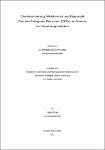Charakterisierung, Wirtsbereich und Diagnostik Porciner Endogener Retroviren (PERV) im Rahmen der Xenotransplantation
Tacke, Stefan
In der vorliegenden Arbeit wurden die Porcinen Endogenen Retroviren (PERV) erstmals ausführlich biochemisch und biologisch charakterisiert sowie ihr Wirtsspektrum und ihre Expression in vitro näher analysiert. Es wurden sensitive immunologische Nachweismethoden entwickelt, die in experimentellen, präklinischen und ersten klinischen Studien zur Xenotransplantation angewandt wurden. Die Charakterisierung der Viren ergab, daß es sich um Typ C-Retroviren handelt, wobei ein Teil der Partikel nicht gereift ist. In hoch gereinigten Viruspräparationen aus Überständen produzierender porciner und PERV-infizierter, humaner Zellen konnten alle Strukturproteine identifiziert werden. Dazu wurden neben Elektrophoresen Western Blot-Analysen eingesetzt, wobei kreuzreaktive Antiseren gegen verwandte Viren und neu entwickelte, erstmals gegen PERV-Proteine gerichtete Antiseren benutzt wurden. Bei der Untersuchung der biologischen Eigenschaften wurde gezeigt, daß PERV in vitro ein mit anderen Retroviren vergleichbares immunsuppressives Potential besitzt. Mit diesen neuen Antiseren und den hoch gereinigten Viruspräparationen wurden sehr sensitive Western Blot-Verfahren sowie ELISAs auf der Basis synthetischer Peptide als Nachweissysteme etabliert und validiert. Zuerst wurden Seren gesunder Blutspender mit diesen Tests untersucht. Dann wurden Seren von Schlachtern und von Patienten nach Xenotransplantationen getestet. Erstmals wurden auch Seren von Pavianen, denen u.a. auch ganze Schweineorganen transplantiert wurden und die eine profunde, für zukünftige Anwendungen typische, pharmakologische Immunsuppression erhielten, auf Antikörper gegen PERV untersucht. Bei Seren einiger Patienten und gesunder Blutspendern wurden zwar Kreuzreaktionen mit viralen Proteinen gefunden, es lagen aber keinerlei Anzeichen für eine PERV-Infektion vor. Um das Wirtspektrum von PERV zu analysieren, wurden Zellinien und erstmals auch primäre Zellen verschiedener Spezies einschließlich Ratte und Maus mit PERV inokuliert. Dabei wurden erstmals Hinweise auf die Suszeptibilität von humanen Blutzellen erhalten. Es konnte gezeigt werden, daß mitogenstimulierte porcine PBMC PERV freisetzen können, wobei alle drei Subtypen der Hüllproteine nachgewiesen wurden. Eine nähere Analyse ergab daß verschiedene Schweinerassen aber auch einzelne Individuen der gleichen Rasse unterschiedliche Mengen an Virus freisetzen. Unter bestimmten Stimulationsbedingungen wurde PERV von adhärenten Zellen produziert, die nicht näher charakterisiert werden konnten. Eine endgültige Beurteilung des Infektionsrisikos bei Xenotransplantationen ist nach Abschluß dieser Studie noch nicht möglich. Mit der Charakterisierung von PERV und den immunologischen Nachweismethoden wurden die Voraussetzung für die Analyse weiterer experimenteller und klinischer Xenotransplantationen gelegt. In this work the porcine endogenous retroviruses (PERV) were biochemically and biologically characterised for the first time. Their host range and expression patterns were closer examined in vitro and sensitive indirect immunological detection systems were established and used in experimental, preclinical, and first clinical xenotransplantation trials. The virus was classified as a type C-retrovirus but only part of its particles were mature. All structural viral proteins could be identified in highly-purified preparations of viral particles from supernatants of producing porcine or PERV-infected human cells. For this, beside electrophoreses, Western Blots were applied using cross-reactive antisera developed against related viruses and newly generated antisera which were for the first time directed against PERV-proteins. Examining the biological characteristics of PERV immunosuppressive effects comparable to these described for related viruses were detected in vitro. Using the new antisera and the highly purified virus preparations very sensitive Western Blotassays and ELISAs based on synthetic peptides were established and validated for the use as immunological detection systems. First, sera from healthy blood donors were tested. Then sera from butchers and from patients after first clinical xenotransplantations were examined. For the first time, sera from baboons that obtained whole organs combined with profound, pharmacological immunosuppression as needed in future clinical trials were examined for the presence of anti-PERV antibodies. Sera from several patients and healthy blood donors showed cross-reactions with viral proteins, but no signs of a PERV-infection were obtained. Studies on the host range of the virus using cell-lines and, for the first time, primary cells amongst them rat- and mouse-cells were inoculated with PERV. Additionally, indications for the susceptibility of human blood cells were obtained. An expression of PERV from porcine PBMC stimulated with mitogens was found. Further analysis revealed differences in the expression patterns between several pig-races but also between individuals from the same race while all three subclasses of envelope proteins could be detected. New stimulation conditions were identified where adherent cells expressed PERV though phenotyping of these cells failed. A final assessment of the risks for a PERV-infection after xenotransplantation based on the results provided in the study is still not possible. The characterisation of PERV and the immunological detection systems build the basis for the analysis of further experimental and clinical xenotransplantations trials.
Dateien zu dieser Publikation
Keine Lizenzangabe

